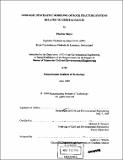Geologic stochastic modeling of rock fracture systems related to crustal faults
Author(s)
Meyer, Thomas, 1970-
DownloadFull printable version (23.58Mb)
Other Contributors
Massachusetts Institute of Technology. Dept. of Civil and Environmental Engineering.
Advisor
Herbert H. Einstein.
Terms of use
Metadata
Show full item recordAbstract
In this study, the capabilities of the MIT three-dimensional geologic stochastic fracture model were extended so that fracture systems related to crustal faulting can be simulated. As presented here, the model comprises four stochastic processes: 1) a homogeneous, anisotropic Poisson process to model the orientation of the potential fracture planes according to an orientation distribution; 2) a homogeneous Poisson line process that tessellates the fracture planes and associates the polygons with fractured and intact rock; 3) a zone marking process that retains or discards the polygons according to their location in the modeling volume; 4) a process that translates and rotates the polygons from their original position in order to accommodate local geologic features. This research enhanced the capabilities of the model by introducing various ways of defining the zones in the zone marking process, and by developing new procedures to analyze the connectivity of the fracture systems. Two case studies of fracture systems generation were addressed. The first one discussed the formation of fault zones in igneous rock. It demonstrated that fracture sets with different properties can be generated in different, sharply defined zones of the same modeling volume. The second case analyzed the fracture systems in the bedrock underlying the Aberjona Valley. It showed that a correct treatment of field data could lead to reliable input parameters for the model, and therefore to reliable properties of the simulated fracture systems, in terms of fracture intensity, fracture size, fracture spacing along boreholes and fracture trace length on outcrops. Connectivity assessment of the simulated fracture systems in the bedrock underlying the Aberjona Valley was performed through analysis of the isolated clusters of interconnected fractures (fracture sub-networks). The horizontal extent of the largest sub-networks appeared to be limited to 9 meters in direction East-West and 11 meters in direction North-South, regardless of the size of the modeling volume. The extent in the vertical direction was not limited. The geometry of the sub-networks seems therefore to limit horizontal fracture flow over long distances, while providing significant storage capacity. Simulations of the fracture flow run with a finite element model developed at ETHZ confirmed the geometry of the phreatic surface as observed in field pumping tests. They also pointed out the role of large discontinuities in fracture flow and the need to model large volumes of rock to account for it.
Description
Thesis (S.M.)--Massachusetts Institute of Technology, Dept. of Civil and Environmental Engineering, 1999. Includes bibliographical references (p. 223-225).
Date issued
1999Department
Massachusetts Institute of Technology. Department of Civil and Environmental EngineeringPublisher
Massachusetts Institute of Technology
Keywords
Civil and Environmental Engineering.